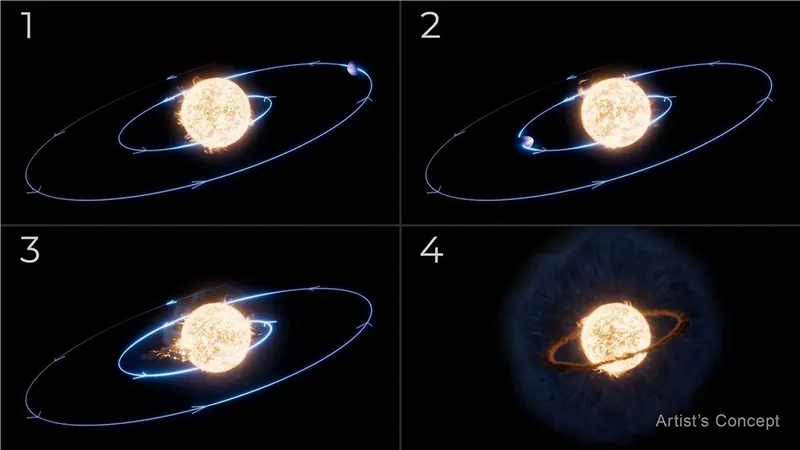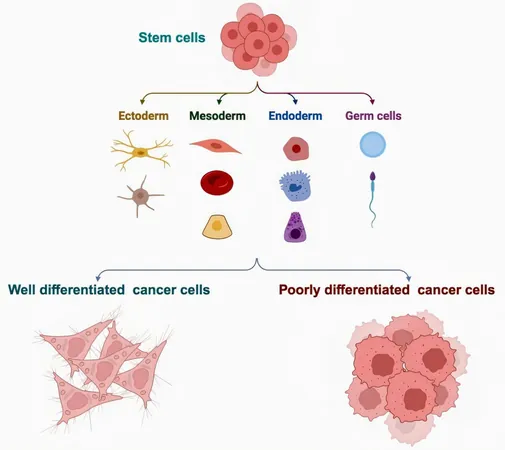
NASA’s Webb Telescope Uncovers Mind-Blowing Truth About Planet-Eating Star!
2025-04-11
Author: Li
NASA’s Webb Makes Shocking Discovery!
Prepare to have your cosmic mind blown! NASA's James Webb Space Telescope has delivered jaw-dropping revelations about a star that was thought to have devoured a planet. Contrary to earlier beliefs that the star simply expanded to swallow its planetary meal, Webb's latest findings reveal a dramatic twist: the planet's orbit actually shrank over time, leading it straight to its doom!
Ryan Lau, the lead astronomer from NSF NOIRLab, expressed the thrill of uncovering such an unexpected event. "We had no clue what to expect, but Webb’s high-resolution infrared capabilities are shedding light on the fateful endings of planetary systems—potentially even our own!"
How the Mystery Unfolded
Located a staggering 12,000 light-years from Earth in the Milky Way, this intriguing star, dubbed ZTF SLRN-2020, was initially spotted for its brilliant flash of optical light at Caltech’s Palomar Observatory. However, NASA's NEOWISE data indicated that the star actually brightened in infrared light a year earlier, hinting at the presence of dust and challenging our earlier notions about its evolution.
While researchers initially believed that the star was aging into a red giant, Webb's MIRI peered deeper into the cosmic event. It told a different story, revealing that the star wasn’t nearly as luminous as expected, debunking the idea that it had expanded to engulf the planet.
A Cataclysmic Dance
So what happened to this planet? Scientists hypothesize it was about the size of Jupiter, orbiting much closer to the star than Mercury does to our Sun! Over millions of years, its orbit spiraled ever closer, leading to a catastrophic demise.
"As the planet began to graze the star’s atmosphere, it initiated a runaway process, drawing it in faster and faster," explained Morgan MacLeod from the Harvard-Smithsonian Center for Astrophysics. In its final moments, the planet dramatically expelled gas from the star's outer layers, leaving an exciting tale of destruction.
What Lies in the Aftermath?
Curious about the cosmic debris left behind? Researchers anticipated observing a vast cloud of cooler dust, but were in for another surprise. NIRSpec, another of Webb’s instruments, revealed a hot disk of molecular gas encircling the star—a potential clue pointing towards the process of planet formation, even if no new planets are emerging in this case.
Colette Salyk, an exoplanet researcher, noted, "I never expected to see what looks like characteristics of a planet-forming region, especially in the aftermath of such an engulfment!" This discovery opens new avenues of inquiry into what exactly unfolded after the star consumed its planetary companion.
On the Cutting Edge of Cosmic Discovery
This groundbreaking study is one of the few we've witnessed in action, as more secrets of the universe await unraveling. Lau hopes that this is just the beginning as researchers plan to employ future observatories like the Vera C. Rubin Observatory and NASA’s Nancy Grace Roman Space Telescope to hunt for similar events.
This astounding research has been published in The Astrophysical Journal, proving once again that the universe continually keeps us on the edge of our seats!
The James Webb Space Telescope, a gem of modern astronomy, is not only solving mysteries within our solar system but also reaching far beyond to uncover the hidden stories of distant worlds and the very fabric of our universe, with backing from NASA, ESA, and CSA.



 Brasil (PT)
Brasil (PT)
 Canada (EN)
Canada (EN)
 Chile (ES)
Chile (ES)
 Česko (CS)
Česko (CS)
 대한민국 (KO)
대한민국 (KO)
 España (ES)
España (ES)
 France (FR)
France (FR)
 Hong Kong (EN)
Hong Kong (EN)
 Italia (IT)
Italia (IT)
 日本 (JA)
日本 (JA)
 Magyarország (HU)
Magyarország (HU)
 Norge (NO)
Norge (NO)
 Polska (PL)
Polska (PL)
 Schweiz (DE)
Schweiz (DE)
 Singapore (EN)
Singapore (EN)
 Sverige (SV)
Sverige (SV)
 Suomi (FI)
Suomi (FI)
 Türkiye (TR)
Türkiye (TR)
 الإمارات العربية المتحدة (AR)
الإمارات العربية المتحدة (AR)